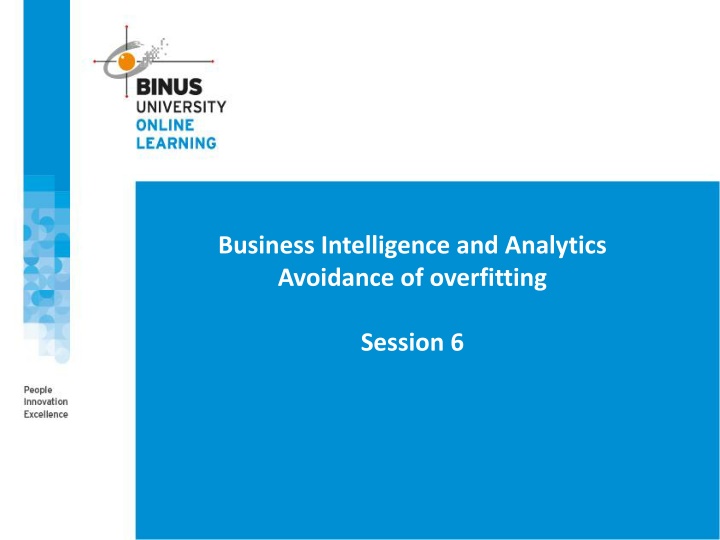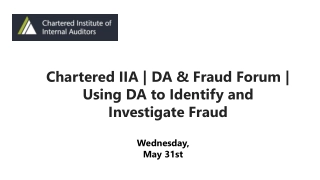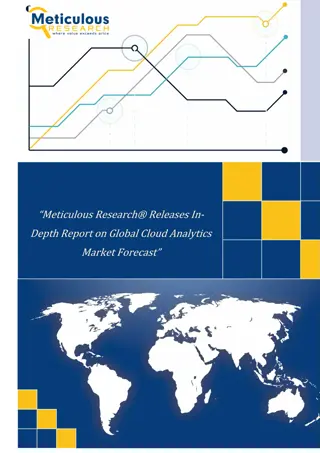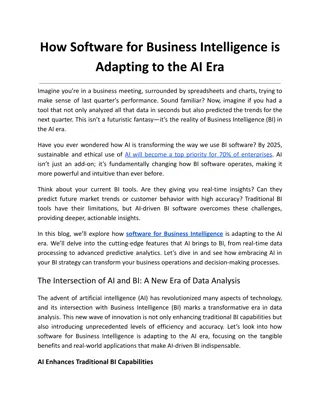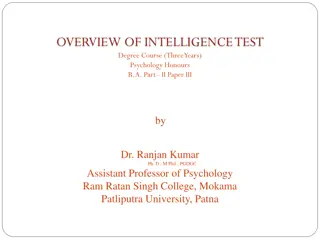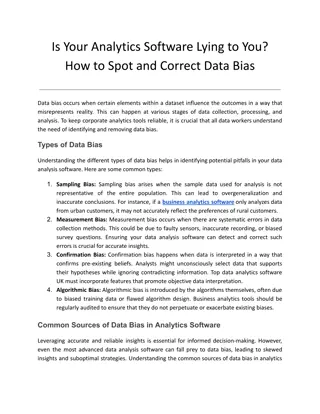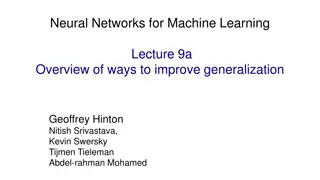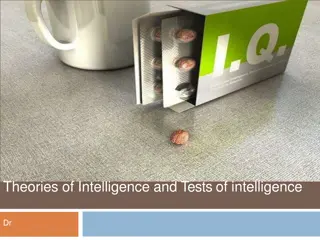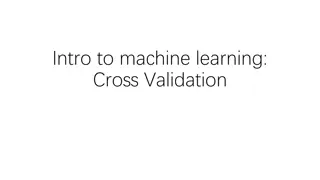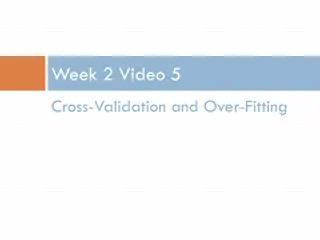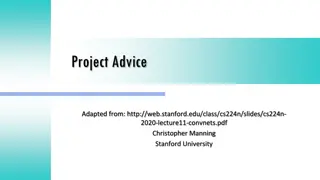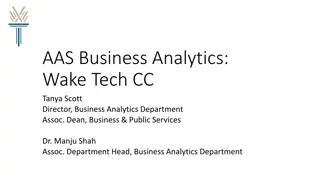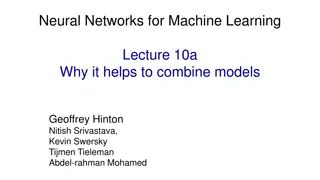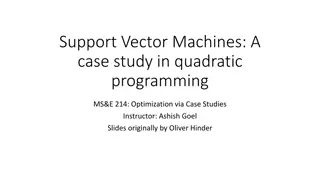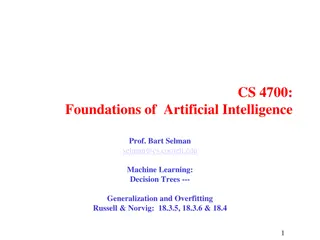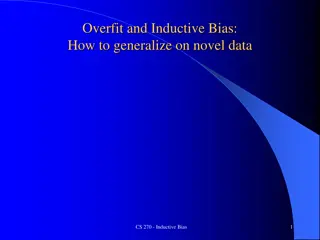Avoiding Overfitting in Business Intelligence and Analytics
In the realm of Business Intelligence and Analytics, it is crucial to navigate the fine line between overfitting and generalization. Overfitting occurs when models capture noise in training data rather than underlying patterns. This session delves into concepts of generalization, overfitting, and strategies to avoid overfitting through complexity control and thoughtful model building. Learn about the trade-off between model complexity and generalizability, essential for creating robust and reliable models for predictive analytics and decision-making.
Download Presentation

Please find below an Image/Link to download the presentation.
The content on the website is provided AS IS for your information and personal use only. It may not be sold, licensed, or shared on other websites without obtaining consent from the author.If you encounter any issues during the download, it is possible that the publisher has removed the file from their server.
You are allowed to download the files provided on this website for personal or commercial use, subject to the condition that they are used lawfully. All files are the property of their respective owners.
The content on the website is provided AS IS for your information and personal use only. It may not be sold, licensed, or shared on other websites without obtaining consent from the author.
E N D
Presentation Transcript
Business Intelligence and Analytics Avoidance of overfitting Session 6
Introduction Fundamental trade-off in DM between overfitting and generalization If we allow ourselves enough flexibility in searching, we will find patterns Unfortunately, these patterns may be just chance occurences in the data We are interested in patterns that generalize, i.e., that predict well for instances that we have not yet observed Overfitting: finding chance occurences in data that look like interesting patterns, but which do not generalize
Agenda Generalization and Overfitting From holdout evaluation to cross-validation Learning curves Overfitting avoidance and complexity control
Generalization (1/2) Example: churn data set Historical data on customers who have stayed with the company, and customers who have departed within six months of contract expiration Task: build a model to distinguish customers who are likely to churn based on some features We test the model based on historical data, and the model is 100% accurate, identifying correctly all the churners as well as the non-churners!? We can always build a perfect model! Store the feature vector for each customer who churned (table model) Look the customer up when determining the likelihood of churning
Generalization (2/2) A table model memorizes the training data and performs no generalization Useless in practice! Previously unseen customer s would all end up with 0% likelihood of churning Generalization is the property of a model or modeling process whereby the model applies to data that were not used to build the model If models do not generalize at all, they fit perfectly to the training data they overfit. DM needs to create models that generalize beyond training data
Overfitting Overfitting is the tendency of DM procedures to tailor models to the training data, at the expense of generalization to previously unseen data points. If you torture the data long enough, it will confess. (Ronald Coase) All DM procedures tend to overfitting Trade-off between model complexity and the possibility of overfitting Recognize overfitting and manage complexity in a principled way
Holdout data Evaluation on training data provides no assessment of how well the model generalizes to unseen cases Idea: Hold out some data for which we know the value of the target variable, but which will not be used to build the model lab test Predict the values of the holdout data (aka test set ) with the model and compare them with the hidden true values generalization performance There is likely to be a difference between the model s accuracy ( in-sample accuracy) and the model s generalization accuracy
Fitting graph A fitting graph shows the accuracy of a model as a function of complexity Generally, there will be more overfitting as one allows the model to be more complex
A fitting graph for the churn example 10
Overfitting in tree induction (1/2) Recall tree induction: find important, predictive individual attributes recursively to smaller and smaller data subsets Eventually, the subsets will be pure we have found the leaves of our decision tree The accuracy of this tree will be perfect! This is the same as the table model, i.e., an extreme example of overfitting! This tree should be slightly better than the lookup table, because every previously unseen instance also will arrive at some classification rather than just failing to match Useful for comparison of how well the accuracy on the training data tends to correspond to the accuracy on test data
Overfitting in tree induction (2/2) Generally: A procedure that grows trees until the leaves are pure tends to overfit If allowed to grow without bound, decision trees can fit any data to arbitrary precision The complexity of a tree lies in the number of nodes
Overfitting mathematical functions There are different ways to allow more or less complexity in mathematical functions Add more variables (more attributes): Add attributes that are non-linear, i.e., or As you increase the dimensionality, you can perfectly fit larger and larger sets of arbitrary points Often, modelers carefully prune the attributes in order to avoid overfitting manual selection Automatic feature selection
Example: Overfitting linear functions (1/2)
Example: Overfitting linear functions (2/2) a) Original Iris data set both logistic regression and support vector machines place separating boundaries in the middle b) A single new example has been added (3,1) logistics regression still separates the groups perfectly, while the SVM line barely moves at all c) A different outlier has been added (4,0.7) again, SVM only moves very little logistic regression appears to be overfitting considerably d) Add a squared term of the sepal width More flexibility in fitting the data seperating line becomes a parabola
Example: Why is overfitting bad? (1/4) Why is overfitting causing a model to become worse? As a model gets more complex, it is allowed to pick up harmful spurious correlations These correlations do not represent characteristics of the population in general They may become harmful when they produce incorrect generalizations in the model Example: a simple two-class problem
Example: Why is overfitting bad? (2/4) Example: a simple two-class problem Classes c1and ?2attributes x and y An evenly balanced population of examples X has two values, p and q, and y has two values, r and s x=poccurs 75% of the time in class ?1 examples and in 25% of ?2examples x providessomepredictionofthatclass Both of y s values occur in both classes equally y has no predictive value at all The instances in the domain are difficult to separate, with only x providing some predictive leverage (75% accuracy)
Example: Why is overfitting bad? (3/4) Small training set of examples A tree learner would split on x and produce a tree (a) with error 25% In this particular dataset,y s values of r and sarenot evenly split between the classes, so y seems to provide some predictness Tree induction would achieve information gain by splitting on y s values and create tree (b) Tree (b) performs better than (a) Because y=r purely by chance correlates with class ci in this data sample The extra branch in (b) is not extraneous, it is harmful! The spurios y=s branch predicts ?2, which is wrong. (error rate: 30%)
Example: Why is overfitting bad? (4/4) This phenomenon is not particular to decision trees It is also not because of atypical training data There is no general analytic way to avoid overfitting
Agenda Generalization and Overfitting From holdout evaluation to cross-validation Learning curves Overfitting avoidance and complexity control 20
Holdout training and testing Cross-validation is a more sophisticated training and testing procedure Not only a simple estimate of the generalization performance, but also some statistics on the estimated performance (mean, variance, ) How does the performance vary across data sets? assessing confidence in the performance estimate Cross-validation computes its estimates over all the data by performing multiple splits and systematically swapping out samples for testing Split a data set into ? partitions called folds (? = 5 or 10) Iterate training and testing ? times In each iteration, a different fold is chosen as the test data. The other ? 1 folds are combined to form the training data.
Illustration of cross- validation Every example will have been used only once for testing but ? 1 times for training Compute average and standard deviation from ? folds
Cross-validation for the churn data set Recall churn dataset with an accuracy of 73% Cross-validation: the dataset was first shuffled, then divided into ten partitions Classification trees: avg accuracy is 68.6% (std 1.1) Logistic regression models: avg accuracy is 64.1% (std 1.3)
Learning curves Generalization and Overfitting From holdout evaluation to cross-validation Learning curves Overfitting avoidance and complexity control
Learning curves Learning curve = a plot of the generalization performance (testing data) against the amount of training data Reflects that generalization performance improves as more training data are available Characteristic shape: steep initially, but then marginal advantage of more data decreases Fitting curve = shows the performance on the training and the testing data against model complexity (for a fixed amount of training data)
Learning curves: example (1/2)
Learning curves: example (2/2) Same data different generalization performance: For smaller training-set sizes, logistic regression yields better generalization accuracy For larger training-set sizes, tree induction soon is more accurate Classification trees are a more flexible model representation than linear logistic regression Smaller data: tree induction will tend to overfit more Flexibility of tree induction for larger training sets Learning curve may give recommendations on how much to invest in training data
Learning curves Generalization and Overfitting From holdout evaluation to cross-validation Learning curves Overfitting avoidance and complexity control
Avoiding overfitting for tree induction (1/3) Tree induction will likely result in large, overly complex trees that overfit the data Stop growing the tree before it gets too complex Prune back a tree that is too large (reduce its size) 30
Avoiding overfitting for tree induction (2/3) Simplest method to limit tree size: specify a minimum number of instances that must be present in a leaf Automatically grow the tree branches that have a lot of data and cut short branches that have less data What threshold should we use? Experience Conduct a hypothesis test at every leaf to determine whether the observed difference in information gain could have been due to chance (e.g., p-value below 5%) Accept split if it was likely not due to chance
Avoiding overfitting for tree induction (3/3) Prune an overly large tree = cut off leaves and branches and replace them with leaves Estimate whether replacing a set of leaves or a branch with a leaf would reduce accuracy If not, prune Continue process iteratively, until any removal or replacement would reduce accuracy Build trees with all sorts of different complexities and estimate their generalization performance Pick the one that is estimated to be the best
A general method for avoiding overfitting (1/2) How to estimate the generalization performance of models with different complexities? Test data should be strictly independent of model building Nested holdout testing Split the training data set into a training subset and a testing subset Build models on the training subset (sub-training) and pick the best model based on the testing subset (validation) Validation set is separate from final test set
A general method for avoiding overfitting (2/2) Use the sub-training/validation split to pick the best complexity without tainting the set Build a model of this best complexity on the entire training set Example for classification trees Induce trees of many complexities from sub-training set Estimate generalization performance from validation set E.g., the best model has a complexity of 122 nodes Estimate the actual generalization performance on final holdout set For the given complexity, induce a new tree with 122 nodes from the original training set
Nested cross-validation Choose the complexity experimentally Cross-validation to assess the generalization accuracy of a new modeling technique with complexity parameter C Run cross-validation as described before Before building the model for each fold, we perform an experiment on the training set Run another entire cross validation on just that training set to find the value of C estimated to give the best accuracy Set the value of C to build the actual model for that fold
Sequential forward selection Based on nested cross-validation Process: Pick the best individual feature by looking at all models built using just one feature Then, test all models that add a second feature to this first chosen feature, and select the best pair Proceed similarly with three, four, features Lots of computational power required
Avoiding overfitting for parameter optimization (1/3) How to find the right balance between the fit to the data and the complexity of the model? Choose the right set of attributes Regularization = combined optimization of fit and simplicity Models will be better if they fit the data better and if they are simpler
Avoiding overfitting for parameter optimization (2/3) Recall: in order to fit a model involving numerical parameters w we need to find a set of parameters that maximize some objective function Complexity control: penalize complexity with ? expressing how important the penalty is Example logistic regression: regularized maximum likelihood model
Avoiding overfitting for parameter optimization (3/3) Most commonly used penalty: L2-norm Sum of the squares of the weights Functions can fit data better if they are allowed to have very large positive and negative weights Sum of squares give a large penalty when weights have large values L1-norm in linear regression lasso Zeroes out many coefficients Performs an automatic form of feature selection
Detour: Support Vector Machine Remember: SVM maximizes the margin between the classes by fitting in the fattest bar Penalization of errors by hinge loss Linear SVM learning is almost equivalent to L2-regularized logistic regression SVM optimizes this equation: Lower hinge loss is better 40
Beware of multiple comparisons Example: If you flip 1000 fair coins many times each, one of them will have come up heads much more than 50% of the time But this is not the best coin! Beware whenever someone does many tests and then picks the results that look good! The actual significance of the results may be dubious Also procedures for avoiding overfitting undertake multiple comparisons, e.g., choosing the best complexity for a model by comparing many complexities
Conclusion Data mining involves a fundamental trade-off between model complexity and the possibility of overfitting. A complex model may be necessary if the phenomenon producing the data is itself complex, but complex models run the risk of overfitting training data (i.e., modeling details of the data that are not found in the general population). An overfit model will not generalize to other data well, even if they are from the same population.
References Provost, F.; Fawcett, T.: Data Science for Business; Fundamental Principles of Data Mining and Data- Analytic Thinking. O Reilly, CA 95472, 2013. Eibe Frank, Mark A. Hall, and Ian H. Witten : The Weka Workbench, M Morgan Kaufman Elsevier, 2016.
